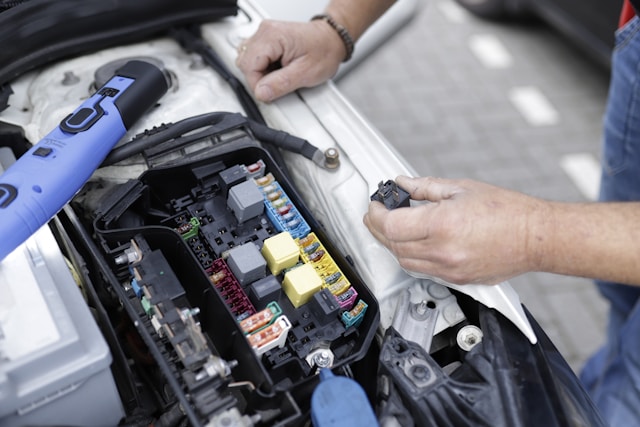Maybe you’re at a point where you’ve decided you’re ready to get rid of your old car, which might just be a gas guzzler. It could be the high gas prices right now that have pushed you in that direction. If so, you might also be looking for something new that will be more eco-friendly and easier on your wallet.
Two similar but also different options are hybrid and electric vehicles. Below, we’ll go into what you should know about these types of cars and how they compare to one another.
Electric Vehicles
An electric vehicle is sometimes referred to as an EV.
Conventional vehicles have an internal combustion engine that uses fuel such as gas and combines it with air. Then, a spark ignites the mixture causing a small explosion. Heat and gas push down on the pistons of the engines and then the car’s wheels move.
An electric vehicle, by contrast, has two components, which are an electric motor of two if it’s an all-wheel drive, and a battery pack. There’s not an internal combustion engine in an EV, nor are there things like a fuel pump or gas tank.
When we talk about electric vehicles, Tesla tends to get most of the recognition, but other vehicles are similarly zero-emission.
A battery-electric vehicle is like the standard among EVs. Popular types of battery-electric vehicles include the Tesla Model 3 and the Nissan Leaf.
A true EV relies only on electricity that comes from plugging it into a power source.
There are also plug-in hybrid vehicles, which we’ll talk about below.
If you have an electric vehicle, the lithium-ion battery works the same across the board. Batteries contain materials like cobalt and aluminum, in addition to lithium. The batteries store energy.
You won’t have to visit a gas station if you invest in a fully electric vehicle, which could feel like a relief in and of itself. You will have to find a public charging station or charge your vehicle before you leave home, but most people don’t have to charge it every day.
A lot of modern EVs can go for hundreds of miles before you need to charge them.
Hybrid Cars
A hybrid car combines at least one electric motor with a traditional gas engine. At times the electric motor does the work, and at other times, the gas engine does. There are also times when they work together. There’s less gas overall, and it improves the fuel economy. The addition of electric power can also improve performance in some cases.
The electricity comes from a high-voltage battery pack. The battery back is replenished through energy capture from deceleration. This occurs because of something called a regenerative braking system.
Hybrids will use the gas engine as a way to maintain and charge the battery.
There’s a lot of variance in hybrid designs and how they work, as well as what the overall goals of the vehicle design are. For example, the design of some hybrids is to maximize fuel savings primarily.
There are different sub-types of hybrids, which include:
- Parallel hybrid: This is the most common design currently, with the electric motor and the gas engine connected in the transmission blending the power of the two. A parallel hybrid transmission might be manual, automatic or continuously variable.
- Series hybrid: The series hybrid has an electric motor providing thrust. There isn’t a physical connection between the wheels and the engine. The gas engine only serves to recharge the battery, so the driving experience, as a result, is more similar to an electric car. There’s smoother acceleration and less vibration.
- Plug-in hybrid: This has a larger battery pack like an electric car’s battery pack, and it is recharged with an external source of electricity. You can do all-electric extended drives and can reduce your fuel consumption quite a bit.
Sometimes hybrid vehicles are broken down into just two larger and more general categories—standard and plug-in hybrids.
What Are the Differences?
Some of the differences between a hybrid and electric are already talked about above, but if you’re considering a new car, it can be helpful to get more specific. A hybrid typically has a lower battery range than an all-electric vehicle.
In a hybrid, the electrical capacity is meant to supplement gas driving and improve overall fuel efficiency.
In some hybrids, there is an electric-only driving mode for low speeds or short ranges.
For a lot of people, a hybrid is a good option because it’s somewhat of an intermediary that helps them reduce fuel consumption, save money and reduce their carbon footprint without the responsibilities and adjustment to full electric.
If you’re someone who doesn’t drive much or you have a short commute, a hybrid can be a good option.
If you have a longer commute or drive longer distances, you might not find that a hybrid works for your needs.
Along with fuel, you have to consider the other costs that come with vehicle ownership. Hybrids tend to have the same maintenance needs and issues as traditional vehicles. For example, you’ll have to change the oil and replace belts.
EVs don’t have the costs typically associated with a combustion engine, but you do need tire changes and to deal with structural damage if it occurs.
Perhaps the biggest maintenance concern to think about with either type of vehicle is battery degradation. If you’re within your warranty period for your battery, you don’t have to pay for a replacement. If you’re past the warranty period, it can be expensive to replace the battery.
Overall, there are, of course, many similarities between an EV and a hybrid, but also some key differences that you should weigh to determine the right choice. Factors to think about include your driving habits, whether there are incentives in your state to purchase any particular type of vehicle, and your goals in getting a new car overall.







